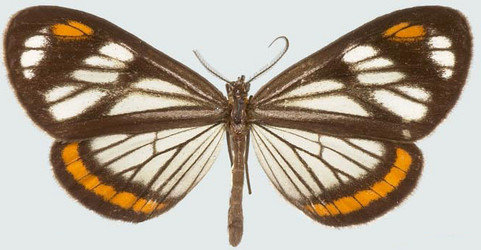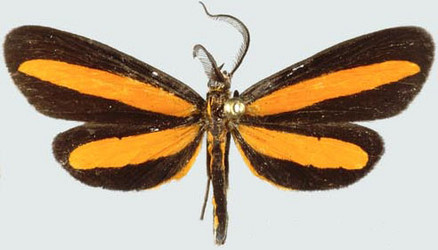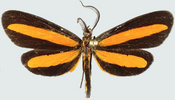Dioptinae
James S. Miller and Andrew V. Z. Brower


This tree diagram shows the relationships between several groups of organisms.
The root of the current tree connects the organisms featured in this tree to their containing group and the rest of the Tree of Life. The basal branching point in the tree represents the ancestor of the other groups in the tree. This ancestor diversified over time into several descendent subgroups, which are represented as internal nodes and terminal taxa to the right.

You can click on the root to travel down the Tree of Life all the way to the root of all Life, and you can click on the names of descendent subgroups to travel up the Tree of Life all the way to individual species.
For more information on ToL tree formatting, please see Interpreting the Tree or Classification. To learn more about phylogenetic trees, please visit our Phylogenetic Biology pages.
close boxIntroduction
The Dioptinae are an almost exclusively neotropical group of day-flying moths, many of which exhibit bright wing coloration and are involved in mimicry rings with butterflies (especially Ithomiini), sterrhine Geometridae and various arctiids. The two specimens illustrated above are representatives of the type species of Dioptis and Josia, the type genera of the two tribes indicated here.
Characteristics
Small, delicate, mostly day-flying Notodontidae which are frequently confused with similarly marked Arctiidae and Geometridae. Miller (2009) points out that the easiest means to distinguish a dioptine is by (1) presence of a metathoracic tympanum, which separates it from Geometridae, whose tympana occur on the first abdominal segment; and (2) a trifid forewing venation, as opposed to quadrifid venation in Arctiidae.References
Although numerous authors have described individual species of Dioptinae, the list of works cited below includes historical and modern efforts to revise the entire group. The classification presented here and in subordinate branches is based on the most recent of these (Miller, 2009).
Bryk, F. 1930. Dioptidae. In: E. Strand (ed.) Lepidopterorum Catalogus 42: 1-65. Berlin, W. Junk.
Hering, EM. 1925. Dioptidae. In: A. Seitz (ed.) Macrolepidoptera of the World. 6:501-534. Stuttgart, Alfred Kernen.
Miller, JS. 2009. Generic revision of the Dioptinae (Lepidoptera: Noctuoidea: Notodontidae). Bulletin of the American Museum of Natural History 321, 1-971 + 48 plates.
Prout, LB. 1918. A provisional arrangement of the Dioptidae. Novitates Zoologicae 25: 395-429.
Title Illustrations

| Scientific Name | Dioptis cyma |
|---|---|
| Location | Brazil: Pará, Belem |
| Reference | Miller JS. 2009. Generic revision of the Dioptinae (Lepidoptera: Noctuoidea: Notodontidae). Bulletin of the American Museum of Natural History 321, 1-971 + 48 plates. (Plate 21) |
| Specimen Condition | Dead Specimen |
| Identified By | James S. Miller |
| Sex | Male |
| Life Cycle Stage | adult |
| View | dorsal |
| Collection | PMNH |
| Collector | Jorge Kesselring |
| Image Use |
 This media file is licensed under the Creative Commons Attribution License - Version 3.0. This media file is licensed under the Creative Commons Attribution License - Version 3.0.
|
| Copyright |
© 2009
James S. Miller

|
| Scientific Name | Josia ligula |
|---|---|
| Location | Brazil: Rondônia, Fazenda Rancho Grande, 200 m |
| Reference | Miller JS. 2009. Generic revision of the Dioptinae (Lepidoptera: Noctuoidea: Notodontidae). Bulletin of the American Museum of Natural History 321, 1-971 + 48 plates. (Plate 32) |
| Specimen Condition | Dead Specimen |
| Identified By | James S. Miller |
| Sex | Male |
| Life Cycle Stage | adult |
| View | dorsal |
| Collection | AMNH |
| Collector | André Sourakov |
| Image Use |
 This media file is licensed under the Creative Commons Attribution License - Version 3.0. This media file is licensed under the Creative Commons Attribution License - Version 3.0.
|
| Copyright |
© 2009
James S. Miller

|
About This Page
Andrew V. Z. Brower

Middle Tennessee State University, Murfreesboro, Tennessee, USA
Correspondence regarding this page should be directed to James S. Miller at
jmiller@amnh.org
and Andrew V. Z. Brower at
abrower@mtsu.edu
Page copyright © 2010 James S. Miller and Andrew V. Z. Brower
 Page: Tree of Life
Dioptinae .
Authored by
James S. Miller and Andrew V. Z. Brower.
The TEXT of this page is licensed under the
Creative Commons Attribution-NonCommercial License - Version 3.0. Note that images and other media
featured on this page are each governed by their own license, and they may or may not be available
for reuse. Click on an image or a media link to access the media data window, which provides the
relevant licensing information. For the general terms and conditions of ToL material reuse and
redistribution, please see the Tree of Life Copyright
Policies.
Page: Tree of Life
Dioptinae .
Authored by
James S. Miller and Andrew V. Z. Brower.
The TEXT of this page is licensed under the
Creative Commons Attribution-NonCommercial License - Version 3.0. Note that images and other media
featured on this page are each governed by their own license, and they may or may not be available
for reuse. Click on an image or a media link to access the media data window, which provides the
relevant licensing information. For the general terms and conditions of ToL material reuse and
redistribution, please see the Tree of Life Copyright
Policies.
- First online 12 August 2009
- Content changed 21 June 2010
Citing this page:
Miller, James S. and Andrew V. Z. Brower. 2010. Dioptinae . Version 21 June 2010 (under construction). http://tolweb.org/Dioptinae/138571/2010.06.21 in The Tree of Life Web Project, http://tolweb.org/









 Go to quick links
Go to quick search
Go to navigation for this section of the ToL site
Go to detailed links for the ToL site
Go to quick links
Go to quick search
Go to navigation for this section of the ToL site
Go to detailed links for the ToL site